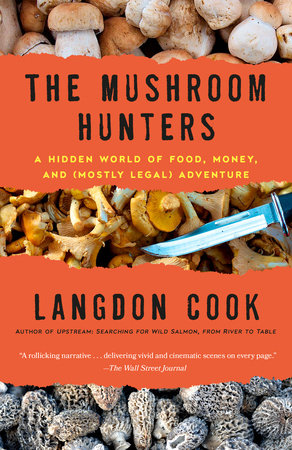Chapter 1
Among the RecreationalsMy obsession with fungi arrived like a sickness. It consumed me. In the immoderate manner I approach all new pursuits, I read just about every book, online treatise, and marginalia I could find. It seemed to me I had something of a knack for stumbling on good mushroom habitat. Maybe this was because of all the hiking and bushwhacking I had done over the years, or maybe it was my youthful crush on birds that gave me a facility with field characteristics. Driving along the highway near my Seattle home, I would catalog the woods I saw and try to imagine what species lived there. Mushrooms often fruit in connection with a specific type of tree. I studied and memorized these kinships. Initially my wife, Martha, was supportive of my new hobby. Soon, though, to her dismay, I was sneaking out at all hours to scout likely patches. I started bringing home what some might consider unreasonable quantities of fungi—pounds and pounds of chanterelles, shaggy manes, giant puffballs, the list goes on—first to eat fresh, and then in such numbers that I cobbled together a homemade dehydrator, bought a stand-up freezer, and even did some pickling in the Mediterranean tradition. The homemade dryer gave way to a dedicated store-bought model, and my map collection grew into an unwieldy binder full of tattered and footnoted quads. I took my compass and mushroom knife wherever I went, just in case.
Ancient Egyptians called mushrooms “the magic food,” with powers of immortality fit only for pharaohs; commoners were forbidden to eat them. In Slavic countries, as far back as anyone can remember, families have gathered beliy grib, the white mushroom, like a crop, as a hedge against hard winters and starvation. In Africa, edible termite mushrooms grow as big as umbrellas, and a single Armillaria fungus spreading across more than two thousand acres of Oregon’s Malheur National Forest is considered the world’s largest organism. Mushrooms have been implicated in the assassination of a Roman emperor and the surrealistic trip down a famous literary rabbit hole. There’s a mushroom that resembles a dead man’s foot and one that looks like a frozen waterfall. Mushrooms are colorful, beguiling, hideous, and transformative.
But more than anything, they are thought of as food. Across much of the globe, through the ages, hunting wild mushrooms has been a regular feature of people’s lives, a rite of passage even. “All Russians know the mushrooms, not by dint of study as the mycologists do, but as part of our ancient heritage, imbibed with our mother’s milk,” writes Valentina Pavlovna Wasson in Mushrooms, Russia, and History. A popular Russian nursery rhyme even includes points of mushroom identification. It’s hard to imagine such children’s verse catching on in North America, save for a cautionary tale about deadly blooms in the woods. Yet even here, in the land of fast food and finicky palates, the allure of the wild mushroom is taking root.
Parked in front of a white tablecloth in a trendy Manhattan restaurant, a curious diner might pause to wonder how all this came about. Not long ago, on a snowy evening near Central Park, I browsed the menu at one of New York’s finest eateries. The quail came with black trumpets. Shaved truffles sexed up a celery root agnolotti. The garganelli corkscrewed fetchingly in a morel cream sauce. The menu was dotted with calligraphed references to chanterelles and porcini, like little colorful caps poking through the forest duff. The fungi, it turned out, even outnumbered the fish. Such riches would have been unimaginable a generation ago. For a mushroom enthusiast like myself—and an increasing number of home cooks and restaurant patrons around the country who know the fungal difference between a lobster and a hedgehog—this quiet revolution of wild edibles has been a culinary bonanza. More and more, diners are discovering that wild mushrooms can stand on their own and replace traditional parts of a meal, even the meat.
My friends tended to view my mushroom compulsion with detached amusement. Even Martha found it hard to fathom. This surprised me because it was Martha who first showed me an edible wild mushroom, in the early days of our courtship, while on a backpacking trip in Olympic National Park. We harvested several pounds of chicken of the woods, a shelf fungus decked out in bright citrus colors, and made an elaborate Italian feast over a camp stove in the wilderness. After this, the domesticated supermarket variety hardly passed muster. For one thing, it’s bland. Selecting mushrooms from a bulk bin—even when they’re periodically updated with new and exotic marketing terms like cremini—can’t begin to match the satisfaction of finding them in the wild. Most people don’t even realize that the Continental-sounding portobello is merely an oversize cremini, both of them being the exact same species, the very domesticated Agaricus bisporus.
A quick primer. All mushrooms are fungi, but not all fungi are mushrooms. The kingdom also includes yeasts, rusts, and mildews—even slime molds. It is a mark of fungi’s otherness that we don’t have a proper lexicon with which to discuss them. Though a mushroom is not technically a fruit, we borrow a term from the plant kingdom and refer to its growth as a fruiting. Thus, a mushroom is the fruiting, reproductive body of a fungus, much as a cherry is the reproductive fruit of a cherry tree. The fungus that produces mushrooms usually—though not always—lives underground in the form of thread-like filaments collectively known as the mycelium, a root-like mass of tiny tendrils. When conditions are right, the mycelium produces a mushroom, which contains the fungus’s reproductive material in the form of spores.
Mushrooms are the great decomposers and recyclers of the world, and they can be categorized in terms of their survival strategies. Note, again, that they’re not plants. They don’t photosynthesize. Instead, they get their nutrients in one of three ways. Some are parasites, like the lobster mushroom, feeding off other living things, even animals. Others are saprobes, recycling dead organic material (wood, dung, humus) into soil. The rest are said to be mycorrhizal, which means they partner with plants in a mutually beneficial exchange of nutrients. Skilled mushroom hunters know how to exploit the various mushrooms’ survival strategies. They can locate colonies of the parasitic honey mushroom, with its tightly packed clusters of amber-colored caps, by finding the dead trees that are its prey; or they can return to a saprophytic lion’s mane mushroom year after year that fruits out of a lightning-struck hardwood. By far the most abstruse relationship is among the mycorrhizal mushrooms. The mushroom hunter seeking chanterelles must understand which plants and trees the chanterelle requires to live. Knowing the trees of the forest is an essential piece of the puzzle.
Only recently has science begun to unravel the mysteries of mushrooms. Turns out, they’re evolutionarily closer to human beings and other members of the animal kingdom than to plants. In other words, fungi and animals share a common relative in the distant past, while plants had already split off the family tree. This commonality between fungi and animals can be seen in chitin, the fibrous substance found in the cell walls of mushrooms and the exoskeletons of arthropods. Fungi have had a profound impact on people and civilizations throughout human history, despite our lack of knowledge. Consider for a moment how baking, brewing, or winemaking would have begun without yeast. Or where we would be without penicillin. In the future we may rely on mushrooms to help clean up oil spills, and the Chernobyl meltdown proved that fungi can mitigate nuclear contamination by literally feeding on radiation. The most obvious use through the centuries, however, can be seen on our dinner tables. Meaty, flavorful, and highly textured, wild mushrooms are a pleasure to cook with and exhibit that sought-after “fifth flavor” popularized in Japan and known as umami, a comforting savoriness that spreads across the palate and coats the tongue, making the diner feel good all over. Many parts of the world have enjoyed long liaisons with fungi, notably Eastern Europe and the Mediterranean, much of Asia, and Mesoamerica. North America is largely a mycophobic region, as passed down from an Anglo-Saxon fear of what lurks in the dark woods. But this is changing.
Copyright © 2013 by Langdon Cook. All rights reserved. No part of this excerpt may be reproduced or reprinted without permission in writing from the publisher.







